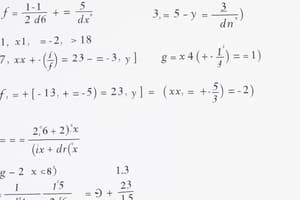Podcast
Questions and Answers
What is the symbolic representation of a function where f represents the function and x is the input?
What is the symbolic representation of a function where f represents the function and x is the input?
- x = f(y)
- y = f(x)
- f(y) = x
- f(x) = y (correct)
How are functions commonly visualized to understand them better?
How are functions commonly visualized to understand them better?
- By drawing schematics
- Using matrices
- With algebraic equations
- Through graphs (correct)
What analogy helps in understanding functions as entities that take inputs and produce outputs based on certain rules?
What analogy helps in understanding functions as entities that take inputs and produce outputs based on certain rules?
- Machines (correct)
- Rocks
- Plants
- Animals
In graphing functions, why do we typically draw lines connecting adjacent points?
In graphing functions, why do we typically draw lines connecting adjacent points?
Which real-life application uses a function to help users find what they want?
Which real-life application uses a function to help users find what they want?
How does writing down your age over time illustrate a function?
How does writing down your age over time illustrate a function?
What is a relation in mathematics?
What is a relation in mathematics?
Which property states that for xRy, yRx must also hold in a relation?
Which property states that for xRy, yRx must also hold in a relation?
If xRy and yRx both hold in a relation, what property does this relation exhibit?
If xRy and yRx both hold in a relation, what property does this relation exhibit?
In a functional relation, what is the characteristic regarding the correspondence between elements of the sets A and B?
In a functional relation, what is the characteristic regarding the correspondence between elements of the sets A and B?
What distinguishes functions from general relations?
What distinguishes functions from general relations?
Which property is crucial for a relation to be considered transitive?
Which property is crucial for a relation to be considered transitive?
Study Notes
Understanding Relations and Functions
In mathematics, relations and functions are fundamental concepts used to represent connections between elements of sets. These ideas form the basis for algebra and calculus, which are crucial parts of many fields including economics, physics, engineering, computer science, and even everyday life. Let's explore these concepts further.
Relations
A relation is simply any set of ordered pairs where each pair consists of one element from each of two different sets. We can visualize this using a Cartesian product A x B, where A and B are the sets involved. For example, if we consider the sets of students in classrooms A and B, a possible relation could be {(Alice, Bob), (Bob, Alice)}. This shows that there is a connection between the members of these sets, indicating that student Alice is related to student Bob.
Relations have several important properties. They can be reflexive, symmetric, antisymmetric, transitive, and/or functional. Reflexivity means that every element relates with itself, symmetry implies that if xRy then yRx, antisymmetry states that if xRy and yRx then x=y, while transitivity indicates that if xRy and yRz, then xRz. Functional relations are those where for each element x in A, there is at most one corresponding element y in B.
Functions
Functions are special types of relations where each element x in A corresponds to exactly one element y in B. In other words, a function assigns a unique value to each input. Mathematically, we denote this as f(x)=y or simply f(x), where f represents the function and x is the input. One common analogy to help understand functions is to think of them as machines that take inputs and produce outputs according to certain rules.
Visualizing functions can be done through graphs, which plot points representing the ordered pairs (x, y). When graphing functions, we typically draw lines connecting adjacent points to create a continuous line, although some functions may lead to discontinuities or more complex shapes.
For instance, consider the simple function f(x) = 2x + 3. Here, if you input 2 into the function, you get 6 back out; inputting -1 gives you 1, and so on. Hence, this function takes in values of 'x' and performs a specific operation on it (multiplying by 2 and adding 3) to give us a result of 'y'.
Real-life Applications
Relations and functions play vital roles in our daily lives. When we shop online, we use a function called a search engine to find what we want. Social media platforms like Facebook use relationships to connect people based on shared interests or mutual friends. Even something as mundane as writing down your age over time illustrates a function because your birth year only increases by one each subsequent year. Thus, understanding these mathematical constructs helps us make sense of the world around us.
Studying That Suits You
Use AI to generate personalized quizzes and flashcards to suit your learning preferences.
Description
Learn about the fundamental concepts of relations and functions in mathematics, which are essential for algebra and calculus. Explore how these concepts are applied in various fields including economics, physics, engineering, and computer science.




